Smart Cities Market Size
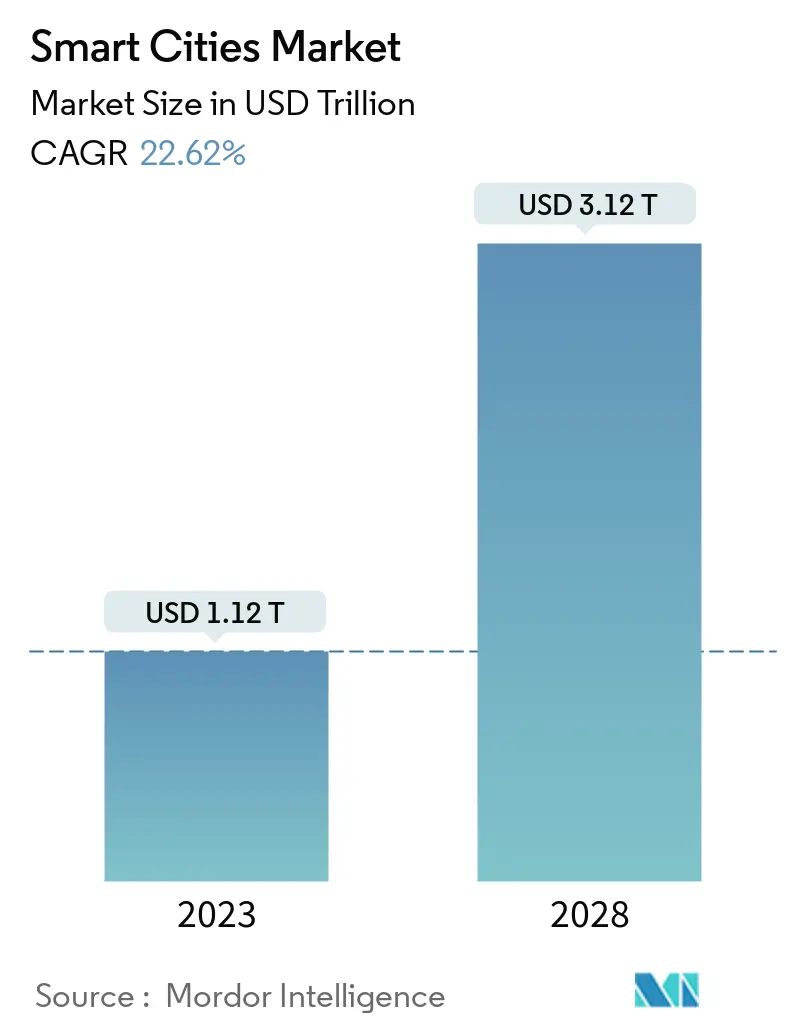
| Study Period | 2018 - 2028 |
| Market Size (2023) | USD 1.12 Trillion |
| Market Size (2028) | USD 3.12 Trillion |
| CAGR (2023 - 2028) | 22.62 % |
| Fastest Growing Market | Asia-Pacific |
| Largest Market | Europe |
Major Players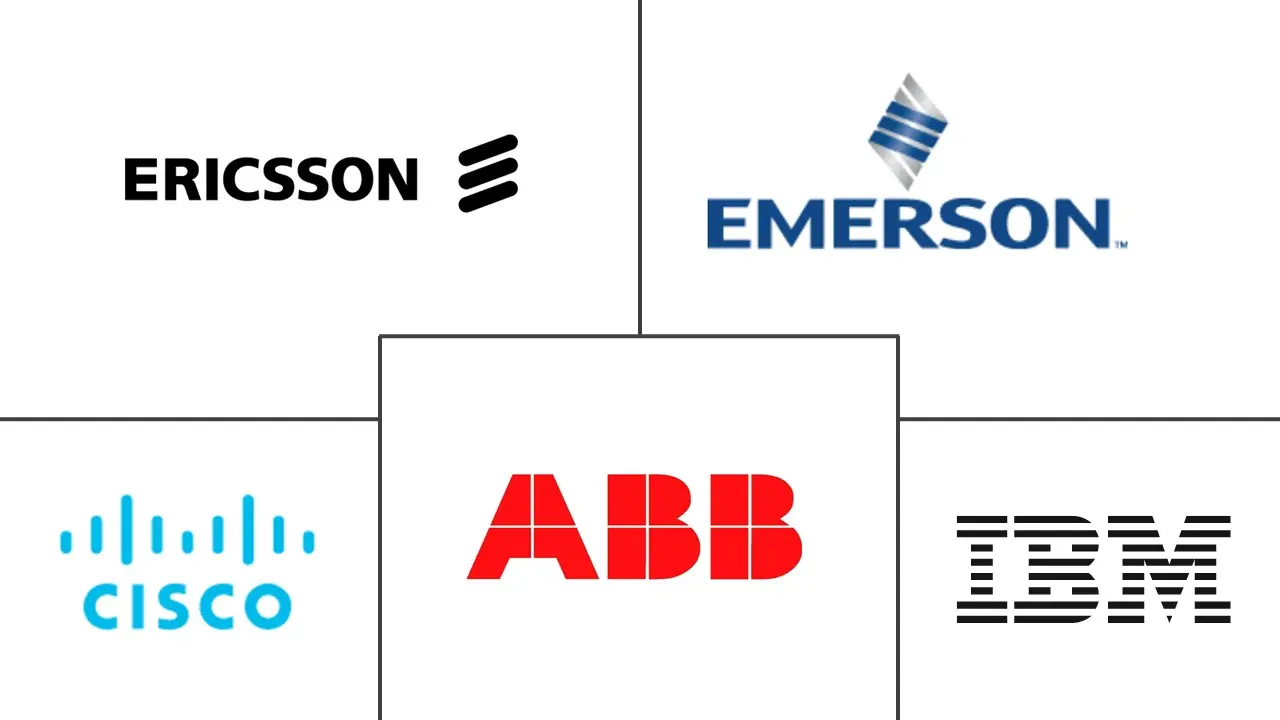
*Disclaimer: Major Players sorted in no particular order |
Need a report that reflects how COVID-19 has impacted this market and its growth?
Smart Cities Market Analysis
The Smart Cities Market size is expected to grow from USD 1.12 trillion in 2023 to USD 3.12 trillion by 2028, at a CAGR of 22.62% during the forecast period (2023-2028).
The market numbers in the study indicate the revenue generated from various types of solutions such as smart mobility management, smart public safety, smart healthcare, smart building, smart utilities, smart security, smart education, and other solutions.
- A smart city is an urban area that makes use of cutting-edge technologies such as artificial intelligence (AI), the Internet of Things (IoT), cloud storage, big data, and data analytics to gather and analyze utilization data and use the insights gained from them to manage resources, services, and assets effectively. Growing government measures to address urbanization and overpopulation and the growing need for resource management for sustainable development are driving growth in the smart cities industry.
- The increased adoption of the internet and the internet of things propel the growth of smart cities and platforms worldwide. It is expected that by the next three years, there will be more than 26 smart cities, with the majority existing in North America and Europe, providing a major drive to the AI and IoT sensors for adoption in smart cities.
- From the first telegraphic fire alarms to radios and dash cams, public safety agencies—law enforcement, fire, EMS, and emergency management—have always been early adopters of the newest technologies. Increasing smart device networks and the development of artificial intelligence are turning public safety technology today from a necessary toolkit into an independent partner that can take action to keep the public safe.
- Data security is the prime concern of every government incorporating the smart city plan, as it is vital in industries such as BFSI, retail, healthcare, and others, owing to the sensitive nature of the data. IoT platforms used for smart cities are experiencing high adoption rates due to IoT demand. This increasing use of these platforms for smart cities across various verticals has increased the vulnerabilities of these systems to data breaches. The need for a uniform security platform is increasing, with many providers offering multiple solutions.
- COVID-19 has propelled the development of smart cities. Smart city infrastructure has helped government agencies avoid the dangerous COVID-19 virus. Post-COVID-19, the government has also been investigating the potential for implementing some smart city technologies to increase urban resilience in times of crisis. The government of Singapore has acknowledged the significance of accelerating the nation's degree of digitization across industries.
Smart Cities Market Trends
This section covers the major market trends shaping the Smart Cities Market according to our research experts:
Rising Adoption of AI and IoT to Drive the Market
- The increased adoption of the internet and the internet of things propel the growth of smart cities and platforms worldwide. It is expected that by 2025, there will be more than 26 smart cities, with the majority existing in North America and Europe, providing a major drive to the AI and IoT sensors for adoption in smart cities.
- The use of IoT has increased, from industrial applications to emergency services, public transportation, public safety, city lighting, and smart city applications. Municipalities are moving to wireless communications offered by IoT due to low cost, greater efficiency, and resource reduction. According to Cisco, machine-to-machine (M2M) connections supporting IoT applications will account for over half of the world's 28.5 billion connected devices by 2022. Connections from smart speakers, fixtures, devices, and associated devices will reach 14.6 billion, and the connected home vertical will account for the bulk of total M2M connections.
- Furthermore, local governments in other parts are investing in smart and adaptive streetlights to improve energy efficiency. For instance, Chicago has launched a smart lighting program that aims to install 270,000 LED lights over four years. During the project's initial year, the city installed 81,000 LED lights. Chicago estimates it will save around USD 10 million yearly in utility costs. The project includes a monitoring and control system that immediately alerts the city of any outages. It also allows workers to optimize the performance of the streetlights.
- As part of the Digital India initiative, the Indian government has planned to push IoT in the country. The government allocated an INR 7,000 crore fund allocation for the development of 100 smart cities powered by IoT devices to control traffic, efficiently use water and power, and collect data using IoT sensors for healthcare and other services.
- With smart city initiatives, the trend of increasing IoT and connected devices is expected to continue over the forecast period. The growing adoption of connected devices that include smart meters, smart homes, smart lighting, and smart transportation, among others that use IoT to connect, is likely to propel the growth of smart city platforms.
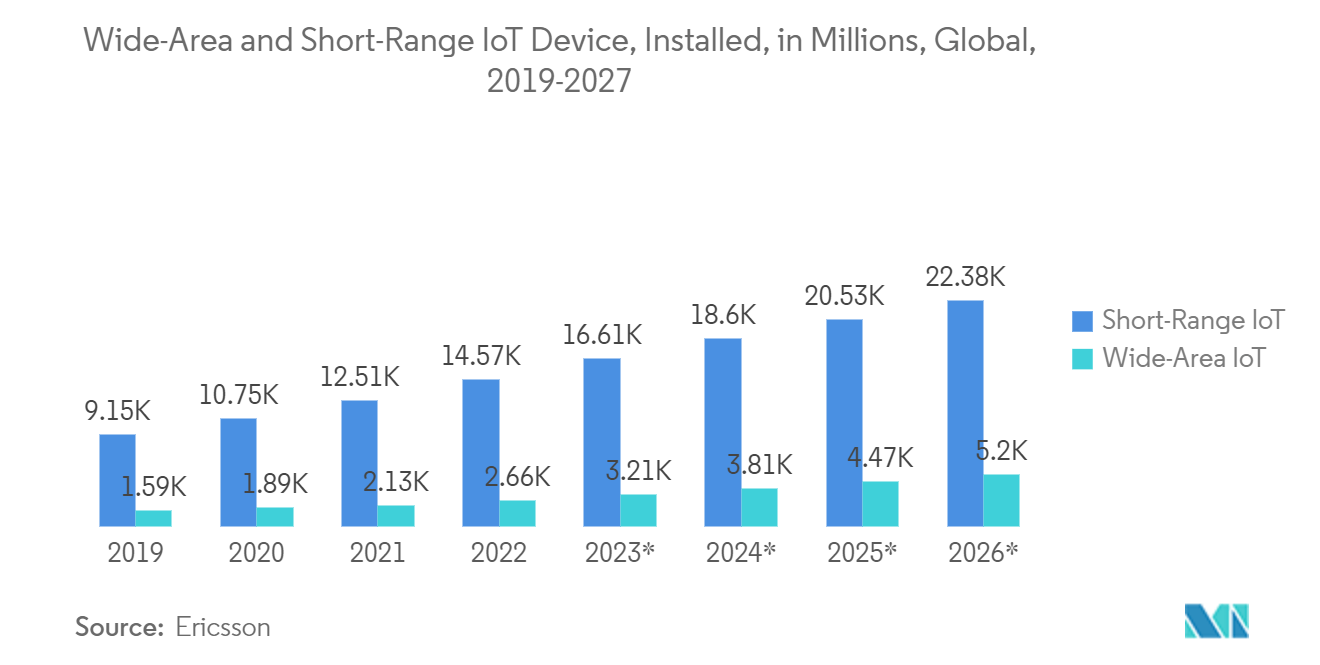
Asia-Pacific is Expected to be the Fastest Growing Market
- Asia-Pacific is one of the fastest-growing regions for innovative city technologies, with China playing a significant role in the market growth. China has made significant investments in the digital transformation of its cities. With its top-down approach to urban development, the country has effectively mobilized its industries and resources to support its national aim of constructing smart cities. China has built smart city infrastructure that has already been applied to many of its main metropolises and sectors through public-private partnerships and the promotion of focused technical innovation.
- A few firms have taken the lead in the transformation of cities as new technologies emerge after decades of research and development. Alibaba, Baidu, Didi Chuxing, Huawei, and Tencent are among those that have integrated their technology in cities such as Hangzhou, Suzhou, Shenzhen, Shanghai, and Beijing. These technologies then serve as the foundation for "digital brains," which use cloud computing, AI, and IoT to lay the groundwork for smart city infrastructure.
- The Japanese government has been supporting the Society 5.0 concept to achieve Sustainable Development Goals by realizing a smart society that provides people with a better quality of life by tightly connecting the internet and physical space. The Japan Government's Strategic Innovation Promotion Program (SIP) has been instrumental in the development of collaboration infrastructure in each field, such as agriculture and transportation infrastructure, as well as the development of inter-field data collaboration infrastructure to connect them, and the formulation of the Smart City Reference Architecture as a basic design guideline for smart cities.
- Government policies and collaborations towards the development of cities are expected to drive the studied market. For Instance, The India Urban Data Exchange was created in collaboration with the Smart Cities Mission and the Indian Institute of Science (IISc) in Bengaluru. IUDX provides a unified interface for data suppliers and users, including ULBs, to share, request, and access datasets relating to cities, urban government, and urban service delivery. IUDX is an open-source software platform that enables secure, authenticated, and managed data exchange between different data platforms, third-party certified and authorized apps, and other sources. As the number of cities on IUDX grows, this would lead to uniform and frictionless data sharing between data producers and consumers throughout urban India.
- The Green Building Council of Australia (GBCA) has revealed the government's Smart Cities Plan, which should increase investment performance and seek to improve the country's sustainability factor. This new plan would make significant adjustments to the existing finances. To begin, it would coordinate and drive smarter city policies. This is done to ensure that both local and national governments are on board with the projected changes. Furthermore, it would endeavor to establish clear models for infrastructure, innovation, and sustainability inside city bounds.
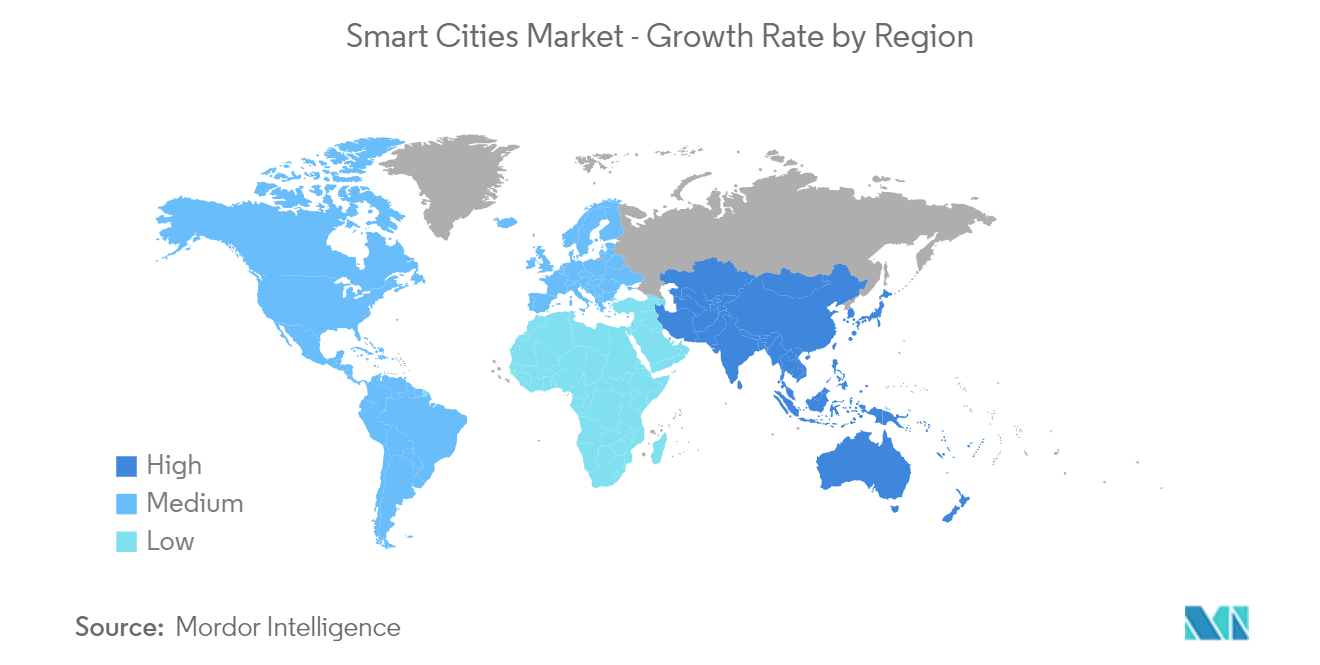
Smart Cities Industry Overview
The smart cities market is moderately fragmented during the forecast period. The major players in the market are ABB Ltd, Cisco Systems Inc., Emerson Electric Co., IBM Corporation, and Ericsson Inc. Players in the market are adopting strategies such as partnerships, innovations, investments, and acquisitions to enhance their product offerings and gain sustainable competitive advantage.
- October 2022 - ABB Ltd acquired ASKI - Industrie-elektronik Gesellschaft m.b.h. The ASKI brand would continue under the ABB Smart Power umbrella, and the team would remain in Zell am Moos, Austria. This acquisition aims to expand the energy segment and the digital energy management ecosystem. The acquisition supports ABB's strategy of developing new energy management features to reduce CO2 emissions and lower energy costs.
- July 2022 - AspenTech, a majority-owned subsidiary of Emerson, announced that it agreed to acquire Micromine, an end-to-end mining software provider. This acquisition is expected to expand AspenTech's software portfolio, furthering the company's diversification strategy into the metals and mining market and facilitating the industry's digital transformation and sustainability goals. The deal with AspenTech accelerates Emerson's software strategy and demonstrates the company's commitment to building a higher-growth, more diverse, and cohesive portfolio. This proposed Micromine acquisition exemplifies how Emerson and AspenTech will drive growth through continued investment and mergers and acquisitions.
Smart Cities Market Leaders
ABB Ltd
Cisco Systems Inc.
Emerson Electric Co.
IBM Corporation
Ericsson Inc.
*Disclaimer: Major Players sorted in no particular order
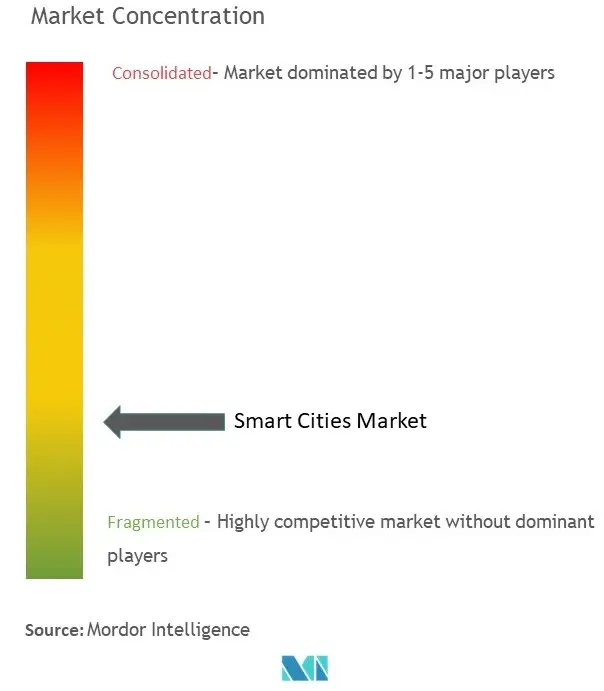
Smart Cities Market News
- November 2022 - Emerson Electric Co. announced the completion of the previously announced USD 3-billion sale of its InSinkErator business to Whirlpool Corporation. InSinkErator was founded in 1938 and acquired by Emerson in 1968. It manufactures food waste disposers and instant hot water dispensers for home and commercial use. Whirlpool Corporation, a home appliance industry leader, is well-positioned to capitalize on InSinkErator's substantial legacy and performance to achieve long-term growth and success.
- July 2022 - Ericsson Inc. acquired Vonage, and Vonage became a wholly-owned subsidiary of Ericsson. With this acquisition with Vonage on board, Ericsson would create a market for simple global network Application Program Interfaces ("APIs"), driving the next wave of digitalization. Ericsson would benefit from bringing Vonage Unified Communications as a Service (UCaaS) and Contact Center as a Service (CCaaS) solutions to its existing customers in the near term.
Smart Cities Market Report - Table of Contents
1. INTRODUCTION
1.1 Study Assumptions and Market Definition
1.2 Scope of the Study
2. RESEARCH METHODOLOGY
3. EXECUTIVE SUMMARY
4. MARKET INSIGHTS
4.1 Market Overview
4.2 Industry Value Chain Analysis
4.3 Industry Attractiveness - Porter's Five Forces Analysis
4.3.1 Bargaining Power of Suppliers
4.3.2 Bargaining Power of Buyers
4.3.3 Threat of New Entrants
4.3.4 Intensity of Competitive Rivalry
4.3.5 Threat of Substitutes
5. MARKET DYNAMICS
5.1 Market Drivers
5.1.1 Rising adoption of AI and IOT
5.1.2 Growth in the need for public safety and security
5.2 Market Challenges
5.2.1 Security Concerns Related to IoT and Smart Devices
5.3 Impact of COVID-19 on the Smart Cities Market
6. MARKET SEGMENTATION
6.1 By Solution
6.1.1 Smart Mobility Management
6.1.2 Smart Public Safety
6.1.3 Smart Healthcare
6.1.4 Smart Building
6.1.5 Smart Utilities
6.1.6 Smart Security
6.1.7 Smart Education
6.1.8 Other Solutions
6.2 By Geography
6.2.1 North America
6.2.1.1 United States
6.2.1.2 Canada
6.2.2 Europe
6.2.2.1 United Kingdom
6.2.2.2 Germany
6.2.2.3 France
6.2.2.4 Sweden
6.2.2.5 Rest of Europe
6.2.3 Asia Pacific
6.2.3.1 China
6.2.3.2 Japan
6.2.3.3 India
6.2.3.4 Australia
6.2.3.5 South Korea
6.2.3.6 Rest of Asia Pacific
6.2.4 Latin America
6.2.4.1 Mexico
6.2.4.2 Brazil
6.2.4.3 Argentina
6.2.4.4 Rest of Latin America
6.2.5 Middle East and Africa
6.2.5.1 Saudi Arabia
6.2.5.2 United Arab Emirates
6.2.5.3 South Africa
6.2.5.4 Rest of Middle East and Africa
7. COMPETITIVE LANDSCAPE
7.1 Company Profiles
7.1.1 ABB Ltd
7.1.2 Cisco Systems Inc.
7.1.3 Emerson Electric Co.
7.1.4 IBM Corporation
7.1.5 Ericsson Inc.
7.1.6 Schneider Electric SE
7.1.7 General Electric Co.
7.1.8 Siemens AG
7.1.9 Huawei Technologies Co. Ltd
7.1.10 Honeywell International Inc.
7.1.11 Hitachi Ltd
7.1.12 Nokia Corporation
7.1.13 Koninklijke Philips NV
- *List Not Exhaustive
8. INVESTMENT ANALYSIS
9. FUTURE OF THE MARKET
Smart Cities Industry Segmentation
A smart city is an urban area that uses different types of electronic methods and sensors to collect data. Insights gained from that data are used to efficiently manage assets, resources, and services. This data is used to improve operations across the city.
The scope of the study tracks various types of smart city solutions, such as smart mobility management, smart public safety, smart healthcare, smart building, smart utilities, smart security, smart education, and other solutions. The report also includes a detailed geography breakdown (North America, Europe, Asia-Pacific, Latin America, and Middle East and Africa). The impact of COVID-19 on the market and affected segments are also covered under the scope of the study. Further, the disruption factors impacting the market's growth in the near future have been covered in the study regarding drivers and restraints. The market sizes and forecasts are provided in terms of value in USD million for all the above segments.
| By Solution | |
| Smart Mobility Management | |
| Smart Public Safety | |
| Smart Healthcare | |
| Smart Building | |
| Smart Utilities | |
| Smart Security | |
| Smart Education | |
| Other Solutions |
| By Geography | ||||||||
| ||||||||
| ||||||||
| ||||||||
| ||||||||
|
Smart Cities Market Research FAQs
How big is the Smart Cities Market?
The Smart Cities Market size is expected to reach USD 1.12 trillion in 2023 and grow at a CAGR of 22.62% to reach USD 3.12 trillion by 2028.
What is the current Smart Cities Market size?
In 2023, the Smart Cities Market size is expected to reach USD 1.12 trillion.
Who are the key players in Smart Cities Market?
ABB Ltd, Cisco Systems Inc., Emerson Electric Co., IBM Corporation and Ericsson Inc. are the major companies operating in the Smart Cities Market.
Which is the fastest growing region in Smart Cities Market?
Asia-Pacific is estimated to grow at the highest CAGR over the forecast period (2023-2028).
Which region has the biggest share in Smart Cities Market?
In 2023, the Europe accounts for the largest market share in the Smart Cities Market.
Smart Cities Industry Report
Statistics for the 2023 Smart Cities market share, size and revenue growth rate, created by Mordor Intelligence™ Industry Reports. Smart Cities analysis includes a market forecast outlook to 2028 and historical overview. Get a sample of this industry analysis as a free report PDF download.
